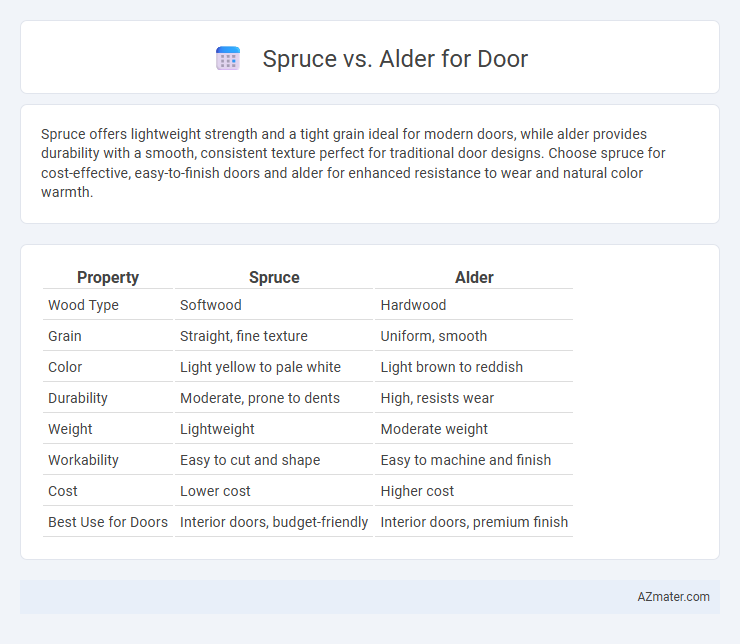Spruce offers lightweight strength and a tight grain ideal for modern doors, while alder provides durability with a smooth, consistent texture perfect for traditional door designs. Choose spruce for cost-effective, easy-to-finish doors and alder for enhanced resistance to wear and natural color warmth.
Table of Comparison
| Property | Spruce | Alder |
|---|---|---|
| Wood Type | Softwood | Hardwood |
| Grain | Straight, fine texture | Uniform, smooth |
| Color | Light yellow to pale white | Light brown to reddish |
| Durability | Moderate, prone to dents | High, resists wear |
| Weight | Lightweight | Moderate weight |
| Workability | Easy to cut and shape | Easy to machine and finish |
| Cost | Lower cost | Higher cost |
| Best Use for Doors | Interior doors, budget-friendly | Interior doors, premium finish |
Introduction to Spruce and Alder for Doors
Spruce doors offer lightweight strength and fine, uniform grain that enhances paint adhesion and smooth finishes. Alder doors provide a rich, warm tone with excellent workability, making them ideal for intricate designs and natural stains. Both woods balance durability and aesthetic appeal, but alder is favored for its subtle knot patterns and consistent texture.
Physical Characteristics of Spruce Wood
Spruce wood, known for its light color and straight grain, exhibits a fine, uniform texture that enhances its visual appeal in door construction. It is a softwood with a moderate density, typically around 400 kg/m3, contributing to its lightweight yet sturdy nature. Spruce's natural high strength-to-weight ratio and good stiffness make it an ideal choice for durable, yet manageable doors compared to Alder's denser and heavier profile.
Physical Characteristics of Alder Wood
Alder wood is known for its fine, uniform texture and straight grain, making it a popular choice for doors that require a smooth finish. It is moderately dense with a Janka hardness of 590, offering good durability and resistance to dents compared to spruce, which is softer with a lower density. Alder's rich brown to reddish hues enhance aesthetic appeal, while its stability and workability ensure ease in shaping, sanding, and staining for high-quality door construction.
Durability and Strength Comparison
Spruce offers moderate durability and lightweight strength, making it suitable for indoor door applications where cost-effectiveness is important. Alder provides greater durability and density, delivering enhanced impact resistance and longevity ideal for doors subject to frequent use or external exposure. When comparing strength, Alder's tighter grain structure contributes to superior hardness and resistance to dents, outperforming Spruce in sturdiness and durability for demanding door installations.
Aesthetic Appeal: Grain and Color Differences
Spruce doors feature a light, creamy color with a straight, fine grain that offers a clean and modern aesthetic ideal for minimalist or Scandinavian designs. Alder doors present a warm, reddish-brown hue with a more pronounced grain pattern, creating a richer, rustic, and traditional visual appeal. The lighter tone of spruce contrasts with alder's deeper color, making each wood type suitable for different interior design themes based on desired warmth and texture.
Workability and Ease of Machining
Spruce offers excellent workability due to its lightweight and straight grain, making it easy to saw, plane, and nail without splitting, ideal for detailed door-making. Alder, although denser than spruce, machines smoothly and holds fasteners well, providing a finer finish and greater stability for door assemblies. Both woods are favored for their ease of machining, but spruce is preferred for quicker projects that require less tool wear, while alder suits applications needing a more refined surface and durability.
Cost and Availability Factors
Spruce is generally more affordable than alder due to its widespread availability and faster growth rates, making it a cost-effective choice for door construction. Alder, while pricier, offers a finer grain and more uniform texture but is less abundant, which can increase lead times and costs. Availability of spruce is higher in North America and Europe, whereas alder supplies may be more localized, impacting pricing fluctuations in different regions.
Insulation and Acoustic Properties
Spruce doors offer moderate insulation with a thermal conductivity around 0.13 W/m*K, making them suitable for energy-efficient homes, while their open grain structure provides decent sound absorption but less acoustic isolation compared to hardwoods. Alder, with a slightly denser wood density of approximately 610 kg/m3, delivers better thermal insulation and superior acoustic dampening due to its tighter cellular structure, effectively reducing noise transmission in residential settings. Choosing Alder doors enhances soundproofing and retains heat more effectively, whereas Spruce doors provide a lighter, cost-effective solution with acceptable insulation and sound control qualities.
Environmental Impact and Sustainability
Spruce doors offer a lower environmental impact due to their rapid growth rate and high availability, leading to more sustainable timber harvesting. Alder wood, while slower-growing, is often sourced from managed forests that prioritize ecosystem balance and carbon sequestration. Choosing spruce supports reduced deforestation pressure, whereas alder emphasizes long-term forest health and biodiversity.
Best Applications for Spruce and Alder Doors
Spruce doors are best suited for interior use due to their light weight, fine grain, and good insulation properties, making them ideal for bedroom, closet, and pantry doors where ease of installation and subtle aesthetics are important. Alder doors excel in applications requiring durability and rich appearance, such as entry doors, cabinet doors, and high-traffic interior environments, thanks to their dense hardwood structure and warm, reddish-brown tone. Choosing between Spruce and Alder depends on desired strength, aesthetic appeal, and the specific location of the door within residential or commercial spaces.

Infographic: Spruce vs Alder for Door
 azmater.com
azmater.com